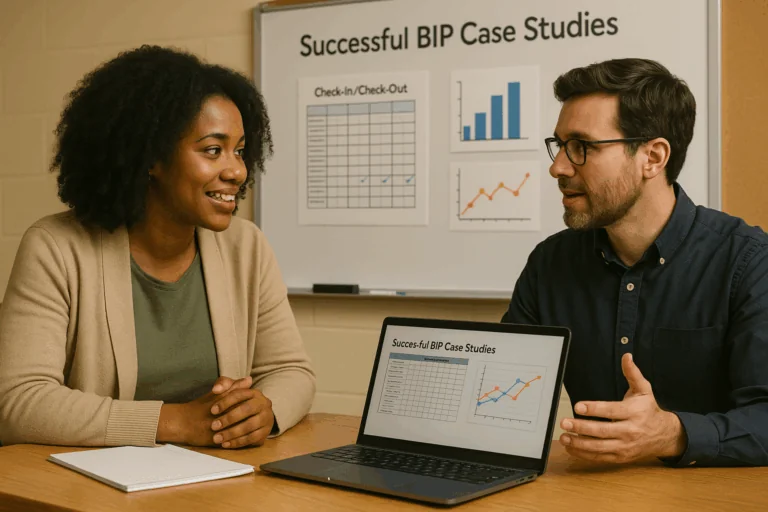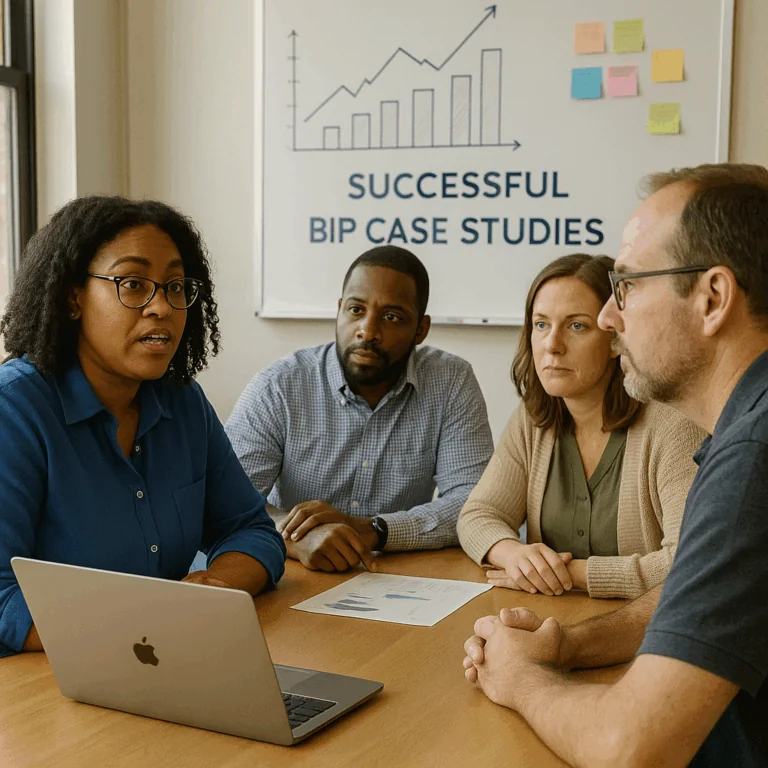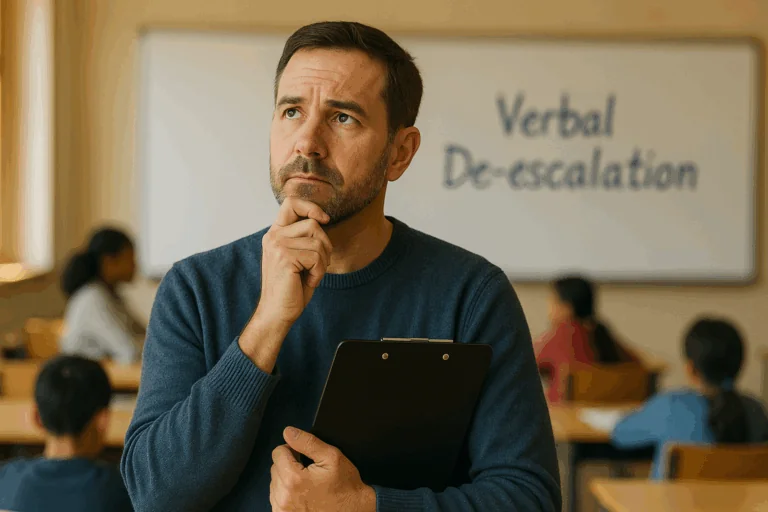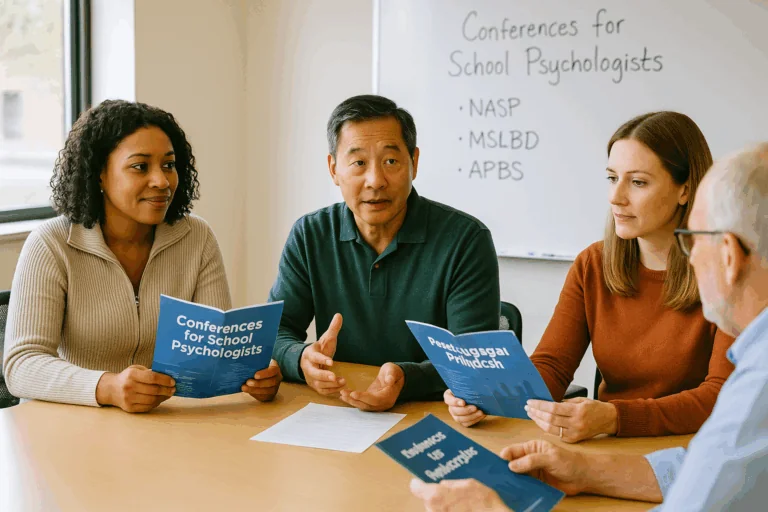Responding to challenging behavior in the classroom often involves a balance between setting firm limits and maintaining positive relationships. One strategy that can be both effective and misunderstood is planned ignoring – or more accurately, removing or minimizing adult attention for inappropriate attention-seeking behaviors while differentially reinforcing appropriate alternative behaviors.
When used thoughtfully, this approach helps students learn that disruptive or inappropriate behavior isn’t an effective way to get attention. But when used in isolation, it can lead to confusion, frustration, and missed opportunities for connection and skill building.
What Is Planned Ignoring and Why Is It a Common Strategy in Schools?
Planned ignoring involves deliberately and briefly withholding attention when a student engages in specific attention-seeking behaviors that are socially inappropriate in the classroom. The goal is to demonstrate-through consistent adult response that these behaviors do not lead to the “payoff” of attention, while appropriate behaviors continue to receive positive reinforcement and recognition.
The reality is that disruptive comments or off-task behaviors need to be addressed quickly and consistently to maintain a positive, structured learning environment. However, when these behaviors become persistent patterns of seeking attention or reaction, even a brief reprimand or correction can unintentionally reward the behavior, making it more likely to occur again.
Importantly, this approach means ignoring the behavior, not the student.
We continue to communicate safety, care, and connection – even while withholding attention for a specific comment, gesture, or disruption. This distinction matters: students should never feel unseen, dismissed, or disconnected from the adults in their environment.
When adults remain calm and consistent in minimizing attention for problem behaviors, they model emotional regulation and provide clear, predictable boundaries that help students understand which behaviors positively contribute to the classroom community.
Keys to Effectively Using Planned Ignoring
Planned ignoring can be a powerful strategy when used thoughtfully and within a comprehensive support plan. It is most effective when the team understands why the behavior is occurring, when the student has already learned appropriate ways to gain attention, and when the classroom environment is rich in positive reinforcement and connection.
- Determine the Function of the Behavior
Planned ignoring should only be used when the function of the behavior is clearly identified as attention-seeking. It should not be used when the behavior is serving an escape or avoidance function – such as task refusal – as ignoring in these cases can unintentionally reinforce avoidance.
Determining the context, pattern, and function of behavior often requires observation, data collection, and team discussion. While a comprehensive Functional Behavior Assessment (FBA) may be needed for more complex cases, remember that FBA exists on a continuum. Sometimes, a collaborative team review of existing data and teacher input is enough to create a shared understanding of the pattern and “payoff” for the behavior.
Looking for a tool to help guide a team-based approach to thinking functionally about behavior? Check out our Simple FBA Form.
- Ensure the Behavior Is Mild or Moderate
Planned ignoring is best suited for behaviors that are low in intensity and pose no safety risk.
It should never replace proactive support or safety planning for situations that could escalate into severe disruption or harm. Teams should always prioritize prevention and safety before using strategies that rely on the temporary removal of attention.
- Teach and Reinforce Appropriate Attention-Seeking Behaviors
For ignoring to be effective, students must already know what to do instead. Teams should intentionally teach and frequently rehearse the skills students can use to seek attention appropriately – such as raising a hand, asking for help, or greeting the teacher.
Tip: Schedule practice and reminders for appropriate attention-seeking behaviors at times when problem behaviors are most likely to occur (e.g., transitions, group work, or unstructured moments). Want to see what this looks like in practice? Watch the short video Practicing, Role-Playing, and Rehearsing Skills for ideas on how to apply these strategies.
- Provide Frequent, Genuine Reinforcement for Appropriate Behavior
Planned ignoring works best in classrooms where positive feedback and recognition are already abundant. When students experience frequent acknowledgment for positive behaviors, brief and subtle ignoring of inappropriate behaviors stands out as a meaningful contrast.
Ignoring should be short-lived and discreet. Respond in a calm and nonreactive way that signals “this behavior won’t get attention.” The student can be acknowledged later if needed, and attention in the moment can instead be directed toward peers who are demonstrating appropriate behavior.
- Maintain a High Ratio of Positive to Corrective Feedback
Put simply, ignoring works when it’s part of a system that provides plenty of positive recognition.
In classrooms with low levels of praise or limited teacher-student connection, ignoring is unlikely to have any meaningful effect—and may even worsen behavior. Maintaining a 5:1 ratio of positive to corrective feedback helps ensure that students continue to feel supported and seen, even as boundaries are enforced.
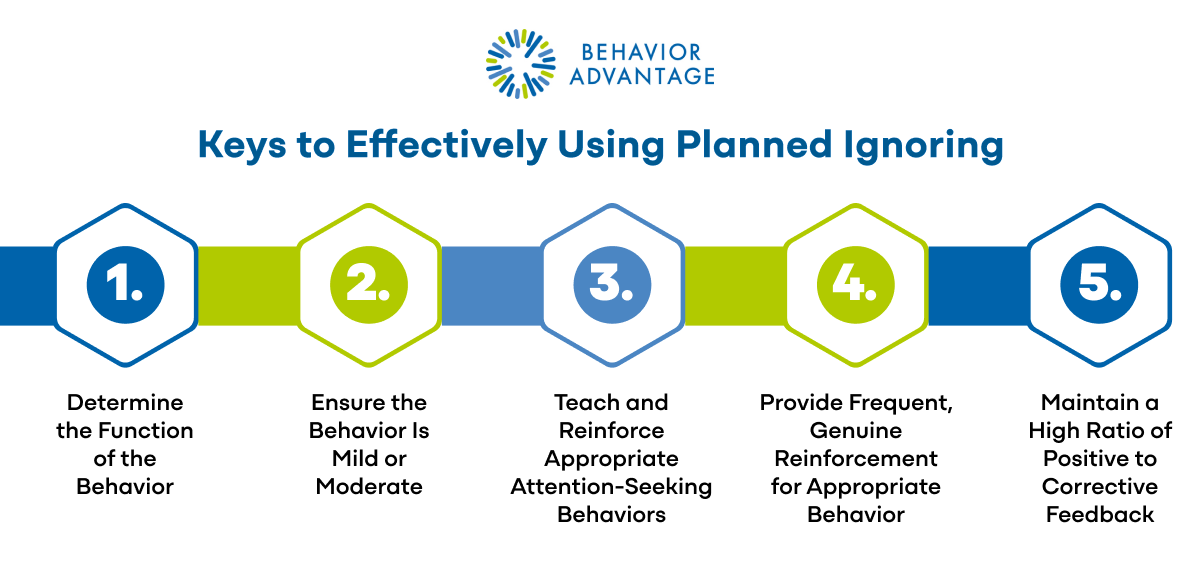
Common Missteps and Misunderstandings
1. Mislabeling “Attention-Seekers” vs. “Connection-Seekers”
Every student needs attention and connection. Some have simply learned less effective or socially inappropriate ways to meet that need. When we label a student as “attention-seeking,” we risk overlooking the deeper need for connection or skill development beneath the behavior.
2. Teaching Must Come First
If a student hasn’t yet learned or practiced appropriate ways to seek attention (raising a hand, asking for help, greeting a teacher, etc.), ignoring inappropriate attempts may be removing the only strategy they know. Before removing attention, we must teach and reinforce the right ways to gain it.
3. Remembering the Human Need to Be Seen
Suddenly removing attention for a student who’s long relied on certain behaviors to gain it can feel like rejection. Even when ignoring a behavior, adults can maintain warmth and presence through proximity, calm tone, and positive recognition for other actions or peers. Every student deserves to feel seen, heard, and valued.
Tips for Using Planned Ignoring Responsibly
- Fill the “Attention Bucket” Early and Often
Students who seek attention most may simply have a bigger need—or an emptier bucket when they arrive each day. Proactively fill that bucket through:
- Positive greetings at the door
- Maintaining at least a 5:1 ratio of positive to corrective feedback
- Assigning classroom jobs or roles that provide responsibility and recognition
- Teach and Practice Appropriate Attention-Seeking Behaviors
Model and rehearse the right ways to get attention – raising a hand, waiting for a turn, asking politely, or giving a signal. Reinforce these immediately and meaningfully so students see the payoff. - Use Planned Ignoring Only When Skills Are in Place
Once students have demonstrated appropriate behaviors and know they work, then minimizing attention for inappropriate behaviors can help strengthen the new pattern. Without that foundation, ignoring is unlikely to lead to meaningful change. - Stay Consistent and Team-Aligned
If only one staff member is ignoring and others are responding, the behavior is still being reinforced. Consistency across the team is essential for planned ignoring to work.
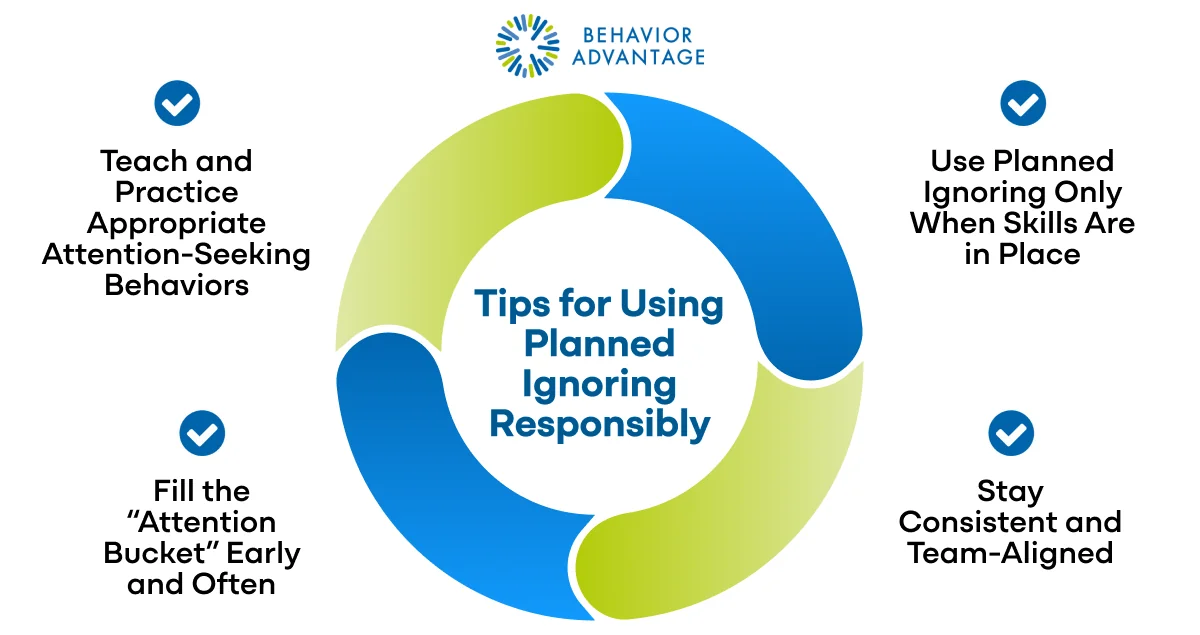
Final Thoughts
Planned ignoring, or removing or minimizing adult attention for inappropriate attention-seeking, can be a powerful component of practical classroom management or a behavior intervention plan. But it is never the whole plan.
When paired with proactive relationship-building, clear instruction, and frequent positive feedback, this strategy helps students learn healthier ways to connect and thrive in the classroom community. Used without those supports, however, it risks sending the message that attention and connection are conditional.
The real goal isn’t to teach students to need less attention, it’s to teach them how to seek it in ways that help them, their peers, and their learning environment flourish.
At Behavior Advantage we aim to equip educators with the best tools to help their students prosper.




